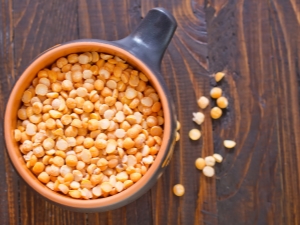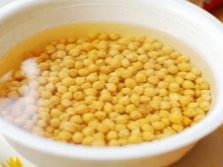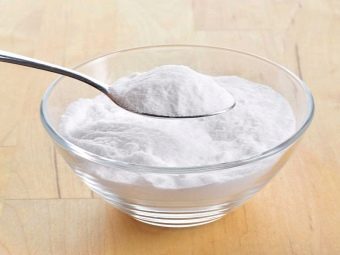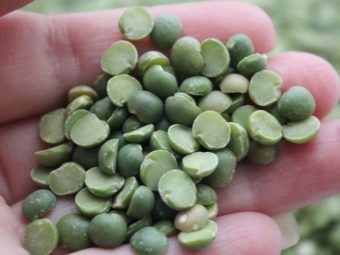How to soak peas before cooking?

Peas are a very useful dietary product, rich in vitamins, minerals and having only 55 kilocalories per 100 grams.In the summer, everyone actively eats fresh peas, and at other times this vegetable is added to soups, side dishes and salads. However, so that the thermally processed product does not lose its excellent taste, it is necessary to include such a procedure as soaking in the cooking process.
Purpose of the procedure
Before cooking, the peas are always washed several times in clean water - this is how starch, dust and dirt are removed. Before that, you need to sort it out, removing the damaged and rotted peas. However, the need to soak hard peas is still questionable. Some cooks believe that this action is necessary, others - that it is a waste of time.
Among the arguments “for” are such things as the ability to reduce the time spent on cooking, and the prevention of bloating. Still, it is better to soak whole peas, because such a product, regardless of the manufacturer and state of the fruit, is boiled for more than two hours, and its pretreatment will shorten this period. As for chipped peas, it is prepared for three quarters of an hour, which is not an excessively long period of time, so you can do without soaking.
The main purpose of soaking is to control the pea readiness time. If it is immediately laid in the soup, then other vegetables can be digested and become soft, and the peas will not reach readiness. And vice versa - the meat may not reach the desired consistency and remain hard, and the peas will already become porridge.
Processing time
Soaking whole peas is carried out for five to eight hours. There is no single rule governing the time for soaking: at night, after breakfast or at lunch. It all depends on when you need a ready dish. Crushed peas, that is, divided into halves, can be soaked for no more than an hour. Depending on the condition of the grains, this time can be a third of an hour.
The fact is that small particles quickly absorb the liquid, and therefore become suitable for further cooking, for example, soup. The use of split peas greatly simplifies the whole cooking process.
Incidentally, if the dish is prepared for cooking in a pressure cooker, then this stage, in general, can be skipped.
Fundamental rules
It is easy and simple to soak peas in cold water - the grains are laid out in a bowl, filled with liquid and left in this position for the required time. The bowl is allowed to put in the refrigerator, only in the warmest part of it. It is important to mention that the amount of water must exceed the amount of peas by two or even three times, and the water must be of low temperature, not higher than fifteen degrees, otherwise the peas will sour.
You can determine the readiness for further heat treatment according to the state of the grains: if their size doubled, then you can start cooking. Before this, drain the water, it would be nice to wash the product several times in clean water. For example, under the tap with running water, until the liquid ceases to be turbid.
Chipped peas, intended for soup, can, in general, avoid soaking - hot water will cope with a double task. Usually, the halves of the fruits are washed, put into the pan and brought to a boil. Together with the peas, you can immediately lay the potatoes, and then other vegetables. Somewhere in half an hour, a maximum of forty minutes spent on a small fire, the dish will be ready to serve.
It is important to bear in mind that during the soaking of the pea one cannot be moved in any way - everything must be in complete rest. Unnecessary movement and stirring will only lead to the appearance of foam or souring.
Useful recommendations
It is important to know the following.
- If you need to cook whole peas quickly, and there is no time to soak them, you can perform the following procedure. First, the peas are thoroughly washed and poured with cold water. The saucepan is put on the stove and brought to a boil.After that, the liquid is drained, changed to cold and again brought to a boil. Then the procedure is repeated one more time. In addition, if the peas were not prepared on time, then it would be right to pour boiling water over it and leave it in this condition for a couple of hours. After that, the cooking time can be limited to half an hour.
- Another interesting way to process peas is soda. This substance will significantly reduce the time required for the pea to change its consistency. The procedure is as follows: a glass of washed peas is poured with four cups of hot water, after which a teaspoon of baking soda is added to the solution. The processing time ranges from thirty minutes to one and a half hours. Then you can start cooking grains.
- The same effect as soda gives a pair of teaspoons of sugar. In addition, both substances prevent further occurrence of flatulence in people who consume the dish. It should be added that the exact amount of soda is calculated as follows: 100 grams of peas and a half liter of water require two teaspoons of soda without a slide. At the end of the procedure, be sure to rinse the product to get rid of soda residue. Ideally, each individual ball is washed under the flowing fluid. Despite the advantages, it is necessary to take into account that soda will destroy vitamin B1 contained in peas, so its use is not always justified.
- It is very important to observe the correct duration of the procedure. If pea perederzhat in water, they sour and begin to create foam. In addition, there will be an unpleasant smell. As a result, the finished dish will not meet the requirements. There is also good advice: in the case when the duration of soaking is more than sixty minutes, the water should be changed every hour. And, of course, it can not be used for the soup itself - the used liquid is drained and replaced with a new one.
- Based on the foregoing, we can conclude that better not soak peas all night or all day - it can stop, sour, and then during cooking, on the contrary, refuse to boil soft.
- Of course, it is important not only not to overdo the peas, but also not to shorten the time of his stay in the water. In the second case, the peas will be hard and not completely swollen. As a result, a dish that includes peas should be spoiled.
- If peas are used to make porridge, then crushed grain can, in general, not soak. In this case, they will cook for fifty minutes. If the peas are still in the water beforehand, it will take no more than half an hour to cook. Pretreatment of whole peas can reach up to five hours.
- It is worth noting that salting peas during this procedure is not recommended - This spice is added at the end of cooking. More precisely, salt is added when less than sixty seconds remain before the end of cooking. If you violate this rule, the dish may take a mushy shape.
- To the room in which the saucepan with peas will be placed, also certain requirements are imposed. It should not be cold and should be continuously airing. If the room temperature is below average, then the soaking time should be extended for a couple of hours. If the room is too hot, the time, on the contrary, is reduced by the same two hours.
- It is worth mentioning that the next logical step after soaking is cooking. It is carried out in clear water over very low heat. The cover is not recommended. Appearing scum should be removed, and water should be refilled, because it will boil all the time. Usually topping up a new fluid is carried out at intervals of thirty minutes. Check the correctness of cooking can be, watching the cooking peas: ideally, they slowly sink to the bottom, and then slowly rise up.
- Old legumes, that is, those that are more than eight months old, will require more soaking time.than those that were recently collected or those that were stored a small amount of time. In addition, wet grains will swell faster and cook faster than dry grains.
- There are two types of peas that do not require such processing: white and peeled crushed. To prevent flatulence, it is possible not to soak, but another procedure: wash the dry peas and pour with cool liquid, then bring everything to a boil, drain the used water and pour the ready broth, which is in the process of boiling, or boiling water. Peas should not remain without boiling water for a minute. Then cooking continues in the traditional way.
Learn more about how to soak peas, you will learn from the following video.






























